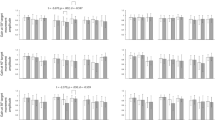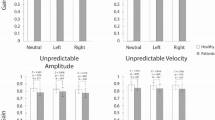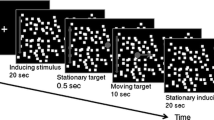Abstract
Purpose
Although several lines of research suggest that the head and eye movement systems interact, previous studies have reported that applying static neck torsion does not affect smooth pursuit eye movements in healthy controls. This might be due to several methodological issues. Here we systematically investigated the effect of static neck torsion on smooth pursuit and saccadic eye movement behavior in healthy subjects.
Methods
In twenty healthy controls, we recorded eye movements with video-oculography while their trunk was in static rotation relative to the head (7 positions from 45° to the left to 45° to right). The subject looked at a moving dot on the screen. In two separate paradigms, we evoked saccadic and smooth pursuit eye movements, using both predictable and unpredictable target motions.
Results
Smooth pursuit gain and saccade peak velocity decreased slightly with increasing neck torsion. Smooth pursuit gains were higher for predictable target movements than for unpredictable target movements. Saccades to predictable targets had lower latencies, but reduced gains compared to saccades to unpredictable targets. No interactions between neck torsion and target predictability were observed.
Conclusion
Applying static neck torsion has small effects on voluntary eye movements in healthy subjects. These effects are not modulated by target predictability.



Similar content being viewed by others
References
Alvarez TL, Semmlow JL, Yuan W, Munoz P (2002) Comparison of disparity vergence system responses to predictable and non-predictable stimulations. Cah Psychol Cog 21:243–261
Bahill T, Clark M, Stark L (1975) The main sequence, a tool for studying human eye movements. Math Biosci 24:191–204
Barnes GR, Collins CJS (2008) Internally generated smooth eye movement: its dynamic characteristics and role in randomised and predictable pursuit. Prog Brain Res 171:441–449
Barnes GR, Donnelly SF, Eason RD (1987) Predictive velocity estimation in the pursuit reflex response to pseudo-random and step displacement stimuli in man. J Physiol 389:111–136
Bruce CJ, Goldberg ME, Bushnell MC, Stanton GB (1985) Primate frontal eye fields. II. Physiological and anatomical correlates of electrically evoked eye movements. J Neurophysiol 54:714–734
Chapman BB, Pace MA, Cushing SL, Corneil BD (2012) Recruitment of a contralateral head turning synergy by stimulation of monkey supplementary eye fields. J Neurophysiol 107:1694–1710
Collewijn H (1999) Eye movement recording. In: Carpenter RHS, Robson JG (ed) Vision research, a practical guide to laboratory methods, 1st edn. Oxford University Press, Oxford, pp 245–285
Colllewijn H, Erkelens CJ, Steinman RJ (1988) Binocular co-ordination of human horizontal saccadic eye movements. J Psysiol 404:157–182
Coppe S, Orban de Xivry JJ, Yüksel D, Ivanoiu A, Lefèvre P (2012) Dramatic impairment of prediction due to frontal lobe degeneration. J Neurophysiol 108:2957–2966
Corneil BD, Munoz DP, Chapman BB, Admans T, Cushing SL (2008) Neuromuscular consequences of reflexive covert orienting. Nat Neurosci 11:13–15
Corneil BD, Elsley JK, Nagy B, Cushing SL (2010) Motor output evoked by subsaccadic stimulation of primate frontal eye fields. PNAS 107:6070–6075
Fukushima K, Akao T, Saito H, Kurkin SA, Fukushima J, Peterson BW (2010) Representation of neck velocity and neck–vestibular interactions in pursuit neurons in the simian frontal eye fields. Cereb Cortex 20:1195–1207
Gabr T, Emara A (2010) Smooth pursuit neck torsion test in patients with cervical spondylosis. Egypt J Otolaryngol 26:37–44
Gagnon D, O’Driscoll GA, Petrides M, Pike GB (2002) The effect of spatial and temporal information on saccades and neural activity in oculomotor structures. Brain 125:123–139
Hess CW, Muri R, Meienberg O (1986) Recording of horizontal saccadic eye movements: methodological comparison between electro-oculography and infrared reflection oculography. Neuro Ophthalmol 6:189–197
Kelders WPA, Kleinrensink GJ, van der Geest JN, Feenstra L, de Zeeuw CI, Frens MA (2003) Compensatory increase of the cervico-ocular reflex with age in healthy humans. J Physiol 553:311–317
Leigh RJ, Zee DS (2006) The neurology of eye movements, 4th edn. Oxford UP, New York
Matsuoka K, Ueda Y (1986) Frequency characteristics of the smooth pursuit component in tracking eye movements. Ergonomics 29:197–214
McSorley E, Findlay JM (2003) Saccade target selection in visual search: accuracy improves when more distractors are present. J Vis 3:877–892
Montfoort I, van der Geest JN, Slijper H, de Zeeuw CI, Frens MA (2008) Adaptation of the cervico- and vestibulo-ocular reflex in whiplash injury patients. J Neurotrauma 25:687–693
Munoz DP, Broughton JR, Goldring JE, Armstrong IT (1998) Age-related performance of human subjects on saccadic eye movement tasks. Exp Brain Res 121:391–400
Paige GD (1994) Senescence of human visual–vestibular interactions: smooth pursuit, optokinetic, and vestibular control of eye movements with aging. Exp Brain Res 98:355–372
Prushansky T, Dvir Z, Pevzner E, Gordon CR (2004) Electro-oculographic measures in patients with chronic whiplash and healthy subjects: a comparative study. J Neurol Neuros Psych 75:1642–1644
Soechting JF, Rao HM, Juveli JZ (2010) Incorporating prediction in models for two-dimensional smooth pursuit. PLoS ONE 5(9):e12574
Sullivan MJ, Hall E, Bartolacci R, Sullivan ME, Adams H (2002) Perceived cognitive deficits, emotional distress and disability following whiplash injury. Pain Res Manag 7:120–126
Tjell C, Rosenhall U (1998) Smooth pursuit neck torsion test: a specific test for cervical dizziness. Am J Otol 19:76–81
Tjell C, Tenenbaum A, Sandström S (2002) Smooth pursuit neck torsion test: a specific test for whiplash associated disorders? J Whip Rel Dis 1:9–24
Treleaven J, Jull G, Lowchoy N (2005) Smooth pursuit neck torsion test in whiplash-associated disorders: relationship to self-reports of neck pain and disability, dizziness and anxiety. J Rehabil Med 374:219–223
Treleaven J, LowChoy N, Darnell R, Panizza B, Brown-Rothwell D, Jull G (2008) Comparison of sensorimotor disturbance between subjects with persistent whiplash associated disorder and subjects with vestibular pathology associated with acoustic neuroma. Arch Phys Med Rehab 89:522–530
van der Geest JN, Frens MA (2002) Recording eye movements with video-oculography and scleral search coils: a direct comparison of two methods. J Neurosci Meth 114:185–195
Wegner AJ, Fahle M (1999) Alcohol and visually guided saccades: gap effect and predictability of target location. Psychopharmacology 146:24–32
Author information
Authors and Affiliations
Corresponding author
Additional information
Communicated by Toshio Moritani.
Rights and permissions
About this article
Cite this article
Janssen, M., de Vries, J., Ischebeck, B.K. et al. Small effects of neck torsion on healthy human voluntary eye movements. Eur J Appl Physiol 113, 3049–3057 (2013). https://doi.org/10.1007/s00421-013-2739-z
Received:
Accepted:
Published:
Issue Date:
DOI: https://doi.org/10.1007/s00421-013-2739-z




